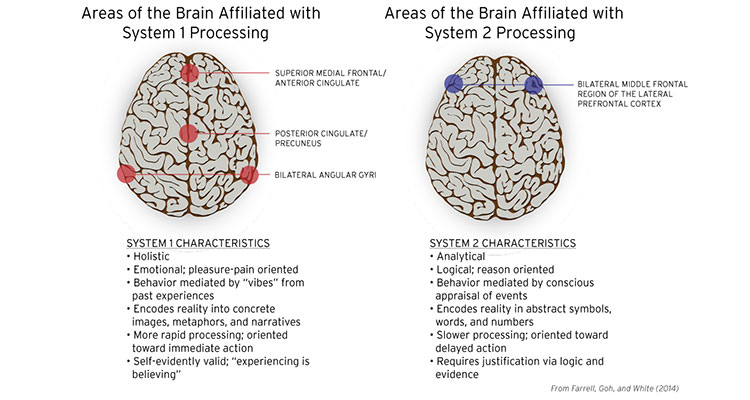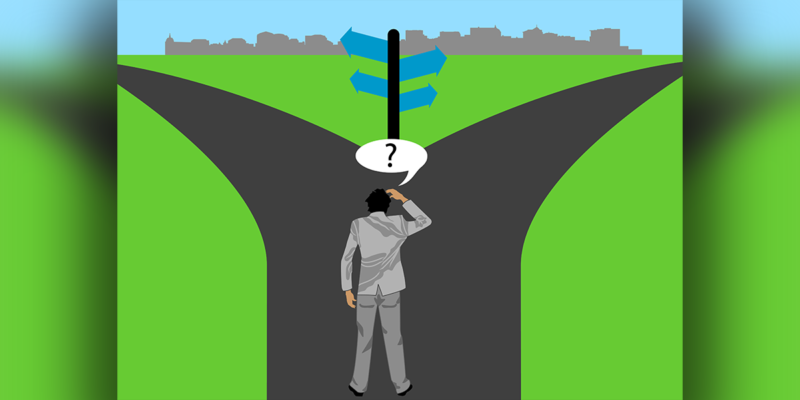The Customer With Two Brains
You may have noticed that magazines and other media have for some time been overflowing with content on left brain vs. right brain and a many other variations on that theme. This is NOT one of those articles. In fact, this article takes a completely different analytical path to understanding decision making and the brain processes involved — one that neuroscientists have only recently begun to fully document and understand.
This freshly “officially accepted by the neuroscience community” enhanced perspective is now at the forefront of brain function research, in spite of the biological fact that this twin brain structure has been around since the dawn of hominids as a species on this planet. Just for the record our family, Hominidae, consists of all erect bipedal primate mammals, including Homo sapiens (us) together with many extinct ancestral and related forms.
As a species, we have evolved during the last 5+ million years a very complex brain structure — largely as a biological necessity — focused on continued existence (a structured complexity shared by only a few other species on the entire planet). The evolution was additive not derivative, thus we maintain all the old simple brain stem-based reflexes and action triggers such as the fight or flight reflex, potential audible threat localization skills and many other survival holdovers. These remain fully functional but have moved down the consciousness detection threshold into the autonomic in our daily routines for the most part. They can still be triggered, often quite unexpectedly, such as the reaction most people have to the two-note shark theme from Jaws- that little shudder down the spine reflex.

How Our Brains Make Decisions
Portions of the next two sections are partially quoted from or suggested by an original interview in First Round called “Master the Art of Influence — Persuasion as a Skill and Habit,” with Tyler Odean, a long time group leader for Chrome at Google. It was first published as a blog here.
To make this as clear as possible, here is a short summary of the basics of the two-system model for how the brain receives and experiences information, based upon information collected from a number of research studies and articles published in neurological journals and related sources. (The following is taken from this blog post interview with Tyler Odean, Director of Product at Reddit and former product leader for Chrome at Google.)
- System I is the part of the brain that handles the simple things: sensory input (ears, eyes, nose, touch, etc.) and the automatic and unimportant decisions (e.g., I’m going to reach for my drink), casual social interactions and other inbound signals that can be processed rapidly and quite easily.
- System II is the top-level, logical part of the brain, the part that thinks at “the speed of the voice in your head.” It brings processing power to bear on decisions and problems that require deeper thought.
When System II is asked to engage, it commonly implements a process similar to that shown in the graphic below to process the information being supplied:

Automatic vs. Decision-based
System I is involuntary; System II is calculating. System I thinks in black and white; System II sees many various shades color as well as levels of gray.

If you think about all the things the brain is constantly handling — it’s not just impressive, it’s really close to astonishing. But you’re able to do it because the part of your brain that you’re aware of, System II, is always outsourcing (finally a legitimate use of that process that doesn’t cost anyone a job, except maybe some of the System 2 neurons) the bulk of the work to System I.
Think of System II as a harassed, overworked but very intelligent supervisor. System I is the army of interns that been hired to solve all the simple problems that can be delegated (outsourced) — even though they occasionally screw up.
The Child In All Of Us
It makes it easier to understand if you think of System I as childlike. Just like an average modern world’s five-year-old views everything in terms of cause and effect — and has absolute certainty about the things they know — System 1 will either believe something with great conviction or not at all — in digital terms it’s a 1 (yes) or 0 (no) decision process. System I has no time for a complex thought process like — “This proposal has a 30 percent probability of working and solving the problem — i.e., being true.” That requires a logical reasoning structure (decision tree) to be executed and that is the job assigned to System II.
The thing you must understand and recognize about System II is that it’s always looking for evidence that something isn’t right or isn’t to be believed. It’s an inherent doubter. And it is also always analyzing the world around it looking for the inconsistent.
So… what does all this neuroscience have to do to do with making a persuasive argument and or closing a sale?
If you speak to System II (i.e. pose something complex enough that it requires reasoning), you’re asking to be distrusted. I’m sure you have had some version of this thought while listening to someone: I don’t know why you’re wrong, but I still don’t believe you. That’s your own version of System II doing its work.

Look at the graphic above — and concentrate on how the two systems make decisions.
To persuade someone, you need to speak as much as you can to System I — the child, the interns — who want to believe you (because it makes yes/no sense).
The simple truth is, however, that most tech professionals express themselves with complexity, overly subtle nuance, and a full-scale artillery barrage of facts and figures. That’s our SOP mindset and it forces most people to turn on/energize their high order processor (System II).
Now you have opened to door to a far more tortuous decision tree and a much higher likelihood of there being a delay or snag in completing the decision or worse yet a rejection of the presentation or sales proposal.
Further, you automatically turned on the doubt meter and its associated logic tree, making it necessary for the person to consider a host of additional variables looking for faults. If, as is often the case with our customers, the people involved are to some degree technophobic or at least concerned about how fast the technology around them is changing, add that into the processing matrix and… oops — serious cause for not making a final decision has just been supplied.
Separating The Two Brains
If you take into account all of the information above you will realize that in addition to sorting your customers/decision makers on a “who has the power” basis you also need to sort them by which brain you need to appeal to when presenting any project.
For example, if your power brokers are typically Brain 1 oriented — i.e., looking for a simple path to a solution to their problem — aim your presentation at that yes/no decision tree. Don’t force them to delve deeply into the details, give them an easy, straightforward path to a conclusion and you will find that your ability to communicate and make your solution work for them goes up.
But, you also know that in the mix are the technically fluent, often IT leaning influencers and decision makers. Clearly, these people are much more likely to be Brain 2 oriented — and are looking for that kind of information, analysis and if you will “food” for their thinking process.
They want to analyze, dissect and “think through” the whole project on an entirely different level, one that involves using their analytical side and their justification and consideration processes to reach a conclusion. If you don’t feed that need they will likely lose interest quickly and start trying to find something to latch on to keep them focused. More than likely that will be something you forgot to mention initially or didn’t break down into fine detail.
Selling Through Neuroscience
This new neuroscience-based selling paradigm requires you to consider carefully how you create, present and engage with your potential customer/buyer. Reviewing all of your current materials with the two brain structure in mind would be a worthwhile exercise. It can and should be of significant help in organizing your sales efforts to these two very different decision structures.
Simply recognizing that the two “brains” exist will drive a non-trivial change in how you deal with the various members of any customer group. You now have an additional level of analysis to consider when designing and making a project presentation. I am NOT suggesting that you abandon any of your current materials or methods, but simply that you look at them in a new light.
The two brains are already there, and acknowledging them and dealing with how you reach out and successfully “talk” to them is something you must plan for. The biology is not going to adapt to you, so you have to adapt to it.





